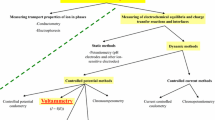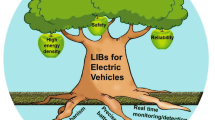We use the method of polarization resistance for the purposes of corrosion monitoring in aqueous technogenic media. The influence of the electrode capacitance and electrochemical transformations in the layer of corrosion products on the accuracy of determination of the polarization resistance is thoroughly investigated. The results of theoretical investigations were used as basic in the development of domestic means of corrosion monitoring. We describe Ukrainian corrosion meters: an R5126 laboratory eight-channel corrosion meter, an ІK-4p portable corrosion meter, and an ІK-4s stationary corrosion meter. The application of corrosion meters makes it possible to perform continuous monitoring of the corrosion state of pipelines, rapidly take measures of corrosion protection, determine the service life of equipment, and perform the repair works in due time.



Similar content being viewed by others
References
L. S. McNeill and M. Edwards, “Iron pipe corrosion in distribution systems,” J. Am. Water Works Assoc., 93, 88–100 (2001).
J. Lin, M. Ellaway, and R. Adrien, “Study of corrosion material accumulated on the inner wall of steel water pipe,” Corros. Sci., 43, 2065–2081 (2001).
P. Sarin, V. L. Snoeyink, J. Bebee, W. M. Kriven, and J. A. Clement, “Physicochemical characteristics of corrosion scales in old iron pipes,” Water Res., 35, 2961–2969 (2001).
A. I. Kheifets, “Implementation of a system for monitoring of the technological equipment of heat networks; experience, and prospects of application,” Novosti Teplosnabzh., No. 4 (92), 40–44 (2008).
C. Andrade and C. Alonso, “Corrosion rate monitoring in the laboratory and on-site,” Constr. Build. Mater., 10, No. 5, 315–328 (1996).
Yu. S. Gerasimenko, Development of the Method of Polarization Resistance and Design of the Corrosion-Measuring Equipment on Its Basis [in Russian], Doctoral Thesis (Engineering), Kiev (1981).
C. Wagner and W. Traud, “Über die Deutung von Korrosionsvorgängen durch Überlagerung von elektrochemischen Teilvorgängen und über die Potentialbildung an Mischelektroden,” Z. Elektrochem. Angew. Phys. Chem., 44, No. 7, 391–402 (1938).
M. Stern and A. L. Geary, “Electrochemical polarization: I. A. theoretical analysis of the shape of polarization curves,” J. Electrochem. Soc., 104, No. 1, 56–63 (1957).
F. Mansfeld, “The polarization resistance technique for measuring corrosion currents,” in: M. G. Fontana and R. W. Staehle (editors), Advances in Corrosion Science and Technology, Vol. 6, Plenum Press, New York (1976), pp. 163–262.
L. I. Antropov, M. A. Gerasimenko, and Yu. S. Gerasimenko, “Determination of the corrosion rate and efficiency of inhibitors by the method of polarization resistance,” Zashch. Met., 2, No. 2, 115–121 (1966).
Yu. S. Gerasimenko, “Nonlinearity of the polarization curve and accuracy of determination of the polarization resistance,” Zashch. Met., 15, No. 6, 673–677 (1979).
Yu. S. Gerasimenko, “Analysis of the structure of the double electric layer in the method of polarization resistance,” Zashch. Met., 20, No. 6, 898–907 (1984).
A. V. Boriskin and Yu. S. Gerasimenko, “Polarization capacitance of corroding steel electrodes,” Fiz.-Khim. Mekh. Mater., Special Issue, No. 4, 41–46 (2004).
Yu. Gerasimenko and A. Boriskin, “Measurements of corrosion rate in systems with high polarization capacitance,” Fiz.-Khim. Mekh. Mater., Special Issue, No. 3, 351–354 (2002).
M. Prazak, “The polarization resistance method for corrosion testing,” Mater. Corros., 25, 104–112 (1974).
N. Azzerri, “Corrosion rate measurements by polarization resistance on hindered surfaces exhibiting pseudocapacitance,” J. Appl. Electrochem., 6, 139–146 (1976).
F. Ijsseling, “Application of electrochemical methods of corrosion rate determination to systems involving corrosion product layers: P. 1: Linear polarization resistance measurement as an example of a simple method that can be performed with commercially available instruments,” Brit. Corros. J., 21, 95–101 (1986).
Yu. S. Herasymenko and H. S. Vasyl’ev, “A two-step method for the evaluation of corrosion rate in metals,” Fiz.-Khim. Mekh. Mater., 45, No. 6, 122–126 (2009); English translation: Mater. Sci., 45, No. 6, 899–904 (2009).
H. S. Vasyl’ev, A. V. Brovchenko, and Yu. S. Herasymenko, “Influence of corrosion products on the measurements of polarization resistance in cold tap water,” Visn. Skhidnoukr. Nats. Univ. Im. V. Dalya, No. 13 (202), 201–211 (2013).
Y. Zou, J. Wang, and Y. Zheng, “Electrochemical techniques for determining corrosion rate of rusted steel in seawater,” Corros. Sci., 53, 208–216 (2011).
J. Wu, D. Bai, A. Baker, Z. Li, and X. Liu, “Electrochemical techniques correlation study of online corrosion monitoring probes,” Mater. Corros., 66, 143–151 (2015).
R. G. Kelly, J. R. Scully, D. W. Shoesmith, and R. G. Buchheit, Electrochemical Techniques in Corrosion Science and Engineering, Marcel Dekker, New York (2003).
S. G. Polyakov and Y. G. Kotlov, “Using corrosion meters of polarization resistance in laboratory and industrial practice,” Fiz.- Khim. Mekh. Mater., 24, No. 5, 95–97 (1988); English translation: Mater. Sci., 25, No. 5, 528–529 (1988).
V. P. Chviruk, S. H. Polyakov, and Yu. S. Herasymenko, Electrochemical Monitoring of Technogenic Media [in Ukrainian], Akademperiodyka, Kyiv (2007).
D. A. Jones and M. D. Greene, “Electrochemical measurement of low corrosion rates,” Corrosion, 22, No. 7, 198–216 (1966).
Retractable Linear Polarization Resistance (LPR) Probe, www.caproco.com/catalog/pdf/Probes-Instruments/Linear-Polarization-Resistance/Low-Pressure-Retractable/Retractable-LPR-2-or-3-Element.pdf.
Cormon Intrusive Measurement Probes, http://www.teledyneoilandgas.com/_document/TDY_317_IntrusiveMeasure_IFS321931_RevC_1.pdf
Linear Polarization Resistance Probe Model LP1000, http://www.alspi.com/lp1000.
Yu. S. Gerasimenko, N. F. Kuleshova, А. V. Boriskin, V. I. Sorokin, and N. V. Fedchenko, “UK-2-type corrosion-indicator installation,” Vodosnabzh. Sanit. Tekh., 11, 23 (1989).
Yu. V. Balaban-Irmenin, V. M. Lipovskikh, and A. M. Rubashov, Protection Against Internal Corrosion of the Pipelines of Heat Water Networks [in Russian], Novosti Teplosnabzheniya, Moscow (2008).
H. S. Vasyl’ev and Yu. S. Herasymenko, “Industrial testing of the means of corrosion monitoring of water-supply systems,” in: Collection of Scientific Works “Modern Problems of Electrochemistry: Education, Science, and Production,” NTU “KhPI”, Kharkiv (2015), pp. 66–67.
Cormon Data Transmitters and Receivers, http://www.teledyneoilandgas.com/_document/TDY_317_DataTransmitter_IFS344988_RevB_1.
MS1000 Corrosion Meter, http://www.alspi.com/manuals/ms1000manual.pdf.
A. V. Popov, V. A. Zhelobetskii, S. V. Bausov, and V. A. Popov, “Diagnostics of corrosive state of main gas pipelines with module probe technology,” Russ. J. Nondestruct. Test., 45, No. 11, 806–809 (2009).
B. V. Koshkin, V. N. Shcherbakov, and V. Yu. Vasil’ev, “Evaluation of the corrosion state of heat networks,” Novosti Teplosnabzh., No. 4 (44), 32–36 (2004).
L. I. Antropov, V. М. Babenkov, Е. А. Budnitskaya, Yu. S. Gerasimenko, М. А. Gerasimenko, and I. А. Korol,’ “R5035 corrosion-rate meter,” Zashch. Met., 12, No. 2, 234 (1976).
Yu. S. Gerasimenko, V. I. Sorokin, N. F. Kuleshova, А. V. Boriskin, N. V. Fedchenko, “UK-type corrosion-indicator installations for the oil industry,” Nauch.-Proizvod. Dostizh. Neftyan. Otrasli Novykh Uslov. Khozyastvov., No. 2, 16–17 (1989).
H. S. Vasyl’ev, “Measurement of polarization resistance with computer logging of results,” Fiz.-Khim. Mekh. Mater., 48, No. 5, 124–126 (2012); English translation: Mater. Sci., 48, No. 5, 694–696 (2013).
Yu. S. Herasymenko and H. S. Vasyl’ev, Microprocessor Device for Measuring the Polarization Resistance [in Ukrainian], Patent 52523. Ukraine. MPK G01N 27/28, Publ. on 25.08.2010, Bull. No. 16.
H. S. Vasyl’ev, R. Yu. Herasymenko, and Yu. S. Herasymenko, “System of automated corrosion monitoring of the pipelines for hot-water supply of a multistory apartment house,” Fiz.-Khim. Mekh. Mater., Special Issue, No. 10, 487–493 (2014).
Author information
Authors and Affiliations
Corresponding author
Additional information
Translated from Fizyko-Khimichna Mekhanika Materialiv, Vol. 52, No. 5, pp. 106–114, September–October, 2016.
Rights and permissions
About this article
Cite this article
Vasyl’ev, H.S., Herasymenko, Y.S. Corrosion Meters of New Generation Based on the Improved Method of Polarization Resistance. Mater Sci 52, 722–731 (2017). https://doi.org/10.1007/s11003-017-0015-9
Received:
Published:
Issue Date:
DOI: https://doi.org/10.1007/s11003-017-0015-9




